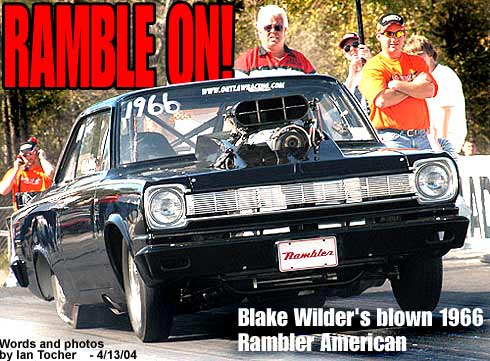
Co-owner John Jenrette (red & white shirt) is a hands-on
crew member between rounds on Blake Wilder's
outrageous Outlaw 10.5 Rambler American.
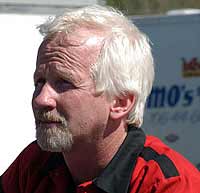 Blake Wilder |
![]() ike the last
kid chosen for a game of schoolyard kickball, a couple of years ago Blake Wilder's
radical '66 Rambler was languishing at Sheppard Race Cars in Covington, GA.
Unfortunately, the man who originally commissioned Dave Sheppard and crew to
build the car passed away before it could be finished.
ike the last
kid chosen for a game of schoolyard kickball, a couple of years ago Blake Wilder's
radical '66 Rambler was languishing at Sheppard Race Cars in Covington, GA.
Unfortunately, the man who originally commissioned Dave Sheppard and crew to
build the car passed away before it could be finished.
"It was just sitting there about 80-percent complete, but nobody would buy it just because it was a Rambler," Wilder recalls. "I mean, it had the best of everything; the guy had not cut corners on any part of the car, but at that time it also had a Rambler engine in it. It was real oddball with an AMC 401 that was up to 456 inches with two Dominators, aluminum heads, nitrous, and everything."
Wilder says he and racing partner John Jenrette had been looking for a new Outlaw 10.5 car for quite some time, but as soon as they saw the Rambler in June 2002, they loved it. "We knew that was it. We didn't want another Camaro or another Mustang, so we got together with the gentleman's wife and made a deal."
After finishing the car, Wilder and Jenrette actually campaigned for a time with the original powerplant intact. "We went five-ohs with the AMC motor in it, and it is the world's fastest AMC," Wilder states. "It'd run 8.40s in the quarter; it just didn't have it on the top end. We probably could've went 7.90s, but every time we tried, it would just burn the motor up."
By the end of the year Wilder and Jenrette knew they wanted to go faster -- and with more reliability -- so they sold the engine to "AMC Doug," a hardcore fan of the brand who just wanted to display it in his basement for bragging rights. Next, they started looking for a used engine and visited the Cavalieri family's Web site (www.cavalieriracing.com), where many top NHRA and IHRA teams farm out their used nitro pieces.
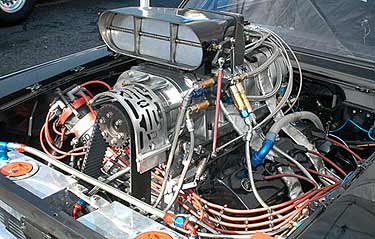 It's a tight fit, but the former Kalitta Racing hemi now looks right at home in the little Rambler. |
|
ADVERTISEMENT
|
Upon arriving back at their shop in Marietta, GA, Wilder says the team was pleasantly surprised to find it fit, "but just barely" after a lot of in-house fabrication to shoehorn the 526-cubic-inch hemi into the engine bay, including machining some pre-made parts and building others from scratch.
The engine currently puts out about 2,100 horsepower, but Wilder is confident it could produce 2,700 with a more aggressive tune-up. Regardless, to make sure the drivetrain stays together when he hits the loud pedal, Wilder went with a Lenco transmission backed up by a Funny Car-grade rearend housing and axles because he wanted to avoid the constant welding repairs that even hand-fabricated steel rearends require. "These cars are 3,000 or 3,100 pounds and we run them so hard that we shake the tires constantly and that can cause stress cracks," he says. "The Mark Williams rearend that we've got in there now is bulletproof. You put it in there and you're done."
One of the more unusual features of the car is the pneumatic clutch pedal and throttle release set-up, similar to what Scotty Cannon ran in his Pro Mod car a few years ago. Powered by a single air tank, one air solenoid triggers a shaft that moves forward to physically hold the clutch pedal in during staging, while a second solenoid holds engine rpm to a pre-set limit despite Wilder's foot pressing the gas pedal to the floor. Wilder had the system installed because nearly all of his Outlaw 10.5 competitors are running automatics with transbrakes. "Your foot can't move off a clutch fast enough to cut a light with a transbrake car," he says. "So, you have to make it air and electric to compete with them."
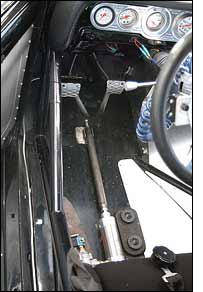 |
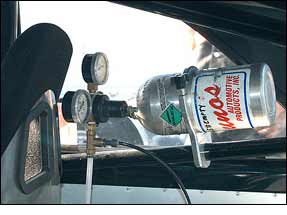 |
|
(above) B&S Shifter built the one-off system that's powered by a compressed air tank mounted behind the passenger seat. (left) The shaft below the driver's left leg is forced forward by air pressure to hold the clutch pedal in while staging. |
"When I stage with the handbrake, I turn the pre-stage light on, push the button, and the air solenoid on the clutch goes out and holds the clutch in at a precise point. Once I hit the button, I take my foot off the clutch and let the solenoid hold it," Wilder explains. "Then, on the air throttle, it goes to the floor and I've got it set at 4,000 rpm. So, I'm on the floor [with my right foot] and I've got my foot off the clutch and it's all being held by air. Then I hold it still with the handbrake, and when the light goes, I let go of the brake and the button and the clutch is released and the throttle slams wide open, all at the same time."
The air bottle that handles the clutch and throttle also provides pneumatic pressure to release the car's Stroud Safety chute after each pass. Wilder says it also makes the chute much easier to pack since there's no spring to compress while tying it off. "There's lots of labor-saving devices on this car. We're older gentlemen, so we need all the help we can get," he jokes.
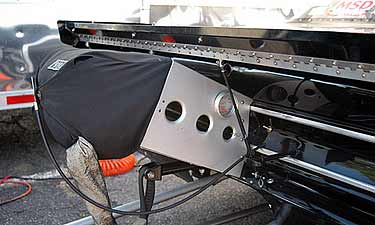 A voltmeter mounted beside the parachute allows Wilder's crewmembers to know there's battery power available for start-up before each pass. |
In the cockpit, Auto Meter gauges keep tabs on all the vital signs and Wilder installed an I-Did-It tilt steering wheel column, originally intended as a street rod piece. "It's just a really unique car and we like to be different," he says. "But we've really been shocked by the welcome we've had for the car and how much people seem to just love it. Even if they're a fan of somebody else, everybody likes the Rambler.
"What the fun part is, is to watch people come up and talk about it and try to figure out what it is. Before we put the Rambler license plate on it they'd stand around and talk for 10 or 15 minutes sometimes, until finally, they'd designate someone to come up to us and ask , 'What is that?' We have a lot of fun with it."
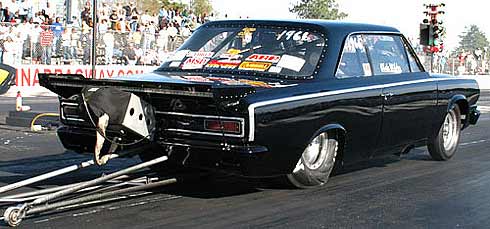
So far, the hemi-powered Rambler has made a best pass
of 4.75 seconds at 157 mph over the 1/8-mile.
|
SPECS
Owners: John Jenrette and Blake Wilder |
Cam: Comp Cams Pistons/Rods: Venolia/Brooks Crank: Sonny Bryant Oiling: Systems 1 Ignition: MSD Mag 44 Headers/Muffler: Homebuilt Transmission: Lenco Clutch: Crower (3 discs) Shifter: B&S Racing Products Differential: Pro Gear/Mark Williams aluminum housing Rear gear ratio: 3.50:1 Axles: Mark Williams Wheelbase: 106 inches Brakes: Wilwood Parachute: Stroud (air-activated) Wheels/Tires: Bogart/Hoosier Gauges: Auto Meter Seats: Cobra Steering column: I-Did-It Best time/Speed (1/8 mile): 4.75 at 157 mph |
Copyright 1999-2004, Drag Racing Online and Racing Net Source